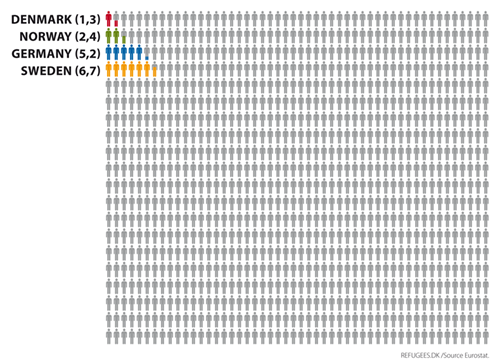How many asylum seekers does Denmark receive compared to the rest of Europe?
The number of asylum applications in Europe is rising again, after first the EU-Turkey deal and then Covid-19 restrictions led to declines.
Every time 1,000 persons seek asylum in Europe, only a few of them ends up in Denmark. This has been the picture for the last 8 years. The numbers are the lowest ever, and Denmark is No. 23 in EU+ measured by capita. Furthermore, every fourth applicant in Denmark already has a residence permit for other reasons – a phenomenon which is not nearly as common in other countries.
The Danish population represents 1 percent of Europe, and when the so-called 'refugee crisis' peeked in 2015 we received a little more than our share, namely 1.6%. Since then we have received far less than our share, calculated by population. Besides, Denmark is among the richest and most well-run countries countries in Europe, so we could reasonably accommodate far more per capita. There is always free capacity in Danish asylum centres while many other countries cannot offer any kind of accommodation – at the moment, Germany is under hard pressure and even had to ask the EU asylum office for help to process the large number of cases. They received 350,000 applications in 2023.
Our two neighbour countries on both sides, Sweden and Germany, have over decades been among the countries in Europe receiving an unproportionate share of refugees. This makes it even more remarkable that Denmark is now at the bottom. Every time 1 asylum seeker arrived in Denmark in 2021, 6 arrived in Germany and 6 in Sweden, per capita.
NEW ASYLUM APPLICATIONS PER 1 MILLION INHABITANTS, EU+, MARCH 2024

The picture below is an illustration of 'the refugee crisis'. In 2016 the largest number of residence pemits to refugees were given since 1995, and these 4 countries were among the ones who granted most per capita. Still a very limited amount of people, seen in proportion. Imagine that this is a large, Danish public school with 1,000 pupils. You come and tell the headmaster that this year, and maybe next year too, 1-2 new pupils will arrive. They will need a little extra help with the language and getting settled. Do you think the headmaster would start talking about a threat to the future and the culture of the school, and decide a total stop for new pupils on indefinite time?
REFUGEES GRANTED ASYLUM PER 1,000 INHABITANTS 2016, 4 countries
The number of asylum seekers in Denmark has followed the tendency in Europe as a whole, non-regarding shifting governments and policies, as you see form the graphic below. The sudden drop seen in new arrivals to Denmark happened in December 2015 and was a direct consequence of the Swedish border control. Shortly after, there was a drop in all of Europe, following the EU-Turkey deal and the intensified control of the outer borders. However, the numbers for Denmark has remained very low compared to the rest of EU, even after the border control to Sweden was loosened up. This is probably mainly due to the negative image that Denmark has built up and somewhat to the fact that it has become very difficult to move North in Europe due to border control.
NUMBER OF ASYLUM SEEKERS IN DENMARK AND EU 2008-2023
Gross numbers (note the measure indicators)
Whether a country receives many asylum seekers is also linked to the country’s geographical location (e.g. Cyprus, Italy and Greece) and how consistently the country takes fingerprints and registers arrivals, and does not necessarily reflect where the asylum seekers wish to claim asylum. For example, many asylum seekers have ended up making their claim in Denmark even though they were on their way to Sweden – and even more traveled through the country without being registered.
The total number of applications (gross number) in Europe is higher than the actual number, as many are registered in more than one country. Around one quarter of all asylum seekers in Denmark are returned to other countries or accepted back to Denmark from other countries because of fingerprints or visa (Dublin procedure), and some have their case dismissed for other reasons.
We provide you with this information for free,
but we depend on private donations to keep going.
Please donate!



